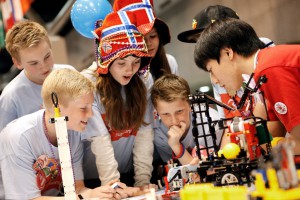Welcome to FIRST® LEGO® League!
FIRST LEGO League is an international enquiry-based program teaching students ages 9 through 16 about science, technology, and collaborative working.
FIRST LEGO League is a partnership between the non-profit organisation FIRST (For Inspiration and Recognition of Science and Technology) and the LEGO Group. It had its first season in 1998. Now more than 233,000 children ages 9 to 16 from over 80 countries take part in this program.
What is FIRST® LEGO® League and how does it work?
FIRST LEGO League is a project-based programme. Over recent years, students participating in the program have looked at a number of annual ‘Challenge’ topics. They include:
- Global climate
- How best to help people with disabilities
- Nanotechnology
- Protecting the oceans
- Keeping food safe
- Helping older people stay independent, engaged, and connected.
The Challenges are developed in co-operation with educators and topic experts from academia, business and industry.

A FIRST LEGO League Challenge consists of three parts:
A research assignment called “The Project” where students research and come up with innovative ideas for solving a defined, real-world challenge
• A “Robot Game” where students design and program a LEGO® MINDSTORMS® robot to solve missions on a special obstacle course
• “Core Values”, the work process the students go through to obtain important life skills such as problem solving, critical thinking, creativity, and team-work.
How does it work?
The annual programme allows students to experience a creative process in which they are in command. Their task is to solve problems and invent solutions inside a tight time frame – just like in real life. Here are the stages:
- A team is formed comprising up to 10 students and at least one adult coach or teacher
- The team registers with the FIRST® LEGO® League partner in their country or region
- The Challenge is announced live on the Internet between late August and early September
- Teams have 8 to 10 weeks to conduct research, come up with an innovative solution to the problem they have identified, prepare and make their presentations
- Teams compete at regional tournaments and present their work to a panel of judges consisting of experts and volunteers
- Winners of regional tournaments advance to national tournaments
- Winners of national tournaments may get the chance to attend international tournaments.

